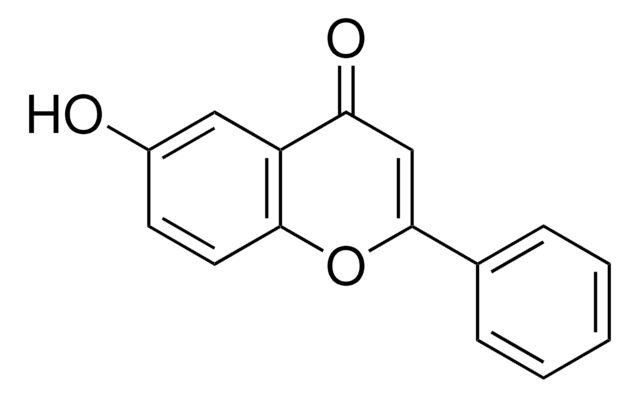C80105
Chrysin
≥96.5% purity, powder
Sinónimos:
5,7-Dihydroxyflavone
About This Item
Productos recomendados
product name
Chrysin, ≥96.5%
assay
≥96.5%
form
powder
color
beige
mp
284-286 °C (lit.)
solubility
0.1 M NaOH: 0.008 g/L
λmax
348 nm
application(s)
diagnostic assay manufacturing
hematology
histology
storage temp.
room temp
SMILES string
Oc1cc(O)c2C(=O)C=C(Oc2c1)c3ccccc3
InChI
1S/C15H10O4/c16-10-6-11(17)15-12(18)8-13(19-14(15)7-10)9-4-2-1-3-5-9/h1-8,16-17H
InChI key
RTIXKCRFFJGDFG-UHFFFAOYSA-N
Gene Information
human ... CDC2(983) , CDK5(1020) , CDK6(1021) , CYP19A1(1588) , CYP1A2(1544) , GSK3A(2931)
mouse ... Hexa(15211) , Ptgs2(19225)
rat ... Gabra2(29706)
¿Está buscando productos similares? Visita Guía de comparación de productos
Application
- Chrysin has been used to study the effect of bioflavonoids on the inhibition of ATP synthase in Escherichia coli.
- It has been used to study the effect of Chrysin on eIF4E (eukaryotic translation initiation factor 4E) expression in AGS cell (human gastric carcinoma cell) line.
- It has been used to study the effect of chrysin on human ovarian cancer cells.
Biochem/physiol Actions
Storage Class
11 - Combustible Solids
wgk_germany
WGK 3
flash_point_f
Not applicable
flash_point_c
Not applicable
ppe
Eyeshields, Gloves, type N95 (US)
Certificados de análisis (COA)
Busque Certificados de análisis (COA) introduciendo el número de lote del producto. Los números de lote se encuentran en la etiqueta del producto después de las palabras «Lot» o «Batch»
¿Ya tiene este producto?
Encuentre la documentación para los productos que ha comprado recientemente en la Biblioteca de documentos.
Los clientes también vieron
Artículos
Antioxidants protect biological systems from oxidative damage produced by oxygen-containing free radicals and from redoxactive transition metal ions such as iron, copper, and cadmium.
Nuestro equipo de científicos tiene experiencia en todas las áreas de investigación: Ciencias de la vida, Ciencia de los materiales, Síntesis química, Cromatografía, Analítica y muchas otras.
Póngase en contacto con el Servicio técnico










